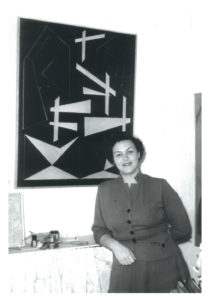Sedje Frank Hénon
 One reason we chose to stop in Amsterdam on the way from Paris to Berlin was to take Violet, who turns 13 on August 1, to see the house of Anne Frank. She and Lilli read Anne’s Diary as they traveled with us. A few hours before we visited that house, I encountered in the Stedelijk Museum another Dutch person who bore the name Frank. Sedje Frank was born to Jewish parents in Rotterdam in 1923. Like Anne, who was born in Frankfurt in 1929 and moved to Amsterdam in 1934, Sedje was also sent to Auschwitz. There, playing violin in the camp orchestra helped her survive.
One reason we chose to stop in Amsterdam on the way from Paris to Berlin was to take Violet, who turns 13 on August 1, to see the house of Anne Frank. She and Lilli read Anne’s Diary as they traveled with us. A few hours before we visited that house, I encountered in the Stedelijk Museum another Dutch person who bore the name Frank. Sedje Frank was born to Jewish parents in Rotterdam in 1923. Like Anne, who was born in Frankfurt in 1929 and moved to Amsterdam in 1934, Sedje was also sent to Auschwitz. There, playing violin in the camp orchestra helped her survive.
Anne and her sister, Margot, were transferred from Auschwitz to Bergen-Belsen concentration camp, where they died of typhus in February 1945 and were buried in a mass grave. The exhibit we saw at the Franks’ hiding place concluded with filmed commentaries by Otto Frank, their father who survived them, and Hanneli Goslar, a friend Anne had known before going into hiding. Just the night before, Steve and I had watched a film Lilli had found about Anne and Hanneli’s friendship.
The surname Anne and Sedje shared inspired me to learn more about Sedje Frank Hénon, as she later became known. After incarceration she spent most of the next three years in a hospital; soon she realized that she was physically unable to play the violin. Instead, she turned to painting and music composition and lived to be 88. I found it remarkable that one Dutch woman named Frank died, but lives on in her writing, while another survived and was able to create lasting art and music.
Sedje Frank Hénon’s art works are part of a remarkable exhibition at the Stedelijk, the museum of contemporary art not far from the Rijksmuseum. The large exhibit, entitled Abstracting Parables, features three distinct voices, each proposing unique understandings of how abstraction can be translated into multiple and complex languages. The exhibition brings together the works of Dutch-Jewish painter and composer Sedje Hémon (1923-2011), Afro-Brazilian painter, poet, essayist, dramatist, and political activist Abdias Nascimento (1914-2011), and Pakistani artist and designer Imran Mir (1950-2014). I had never heard of any of them, but I was glad to learn about them and stretch my horizons. Click here for photos of many of the works in Abstracting Parables. Here are some of the ones by Sedje Hénon:
Sedje Hémon’s artistic practice was strongly influenced by her lived experience as a Shoah survivor. During the 1950s and 1960s, Hémon developed an intricate method for translating her paintings into musical scores. She described her paintings as musical compositions, and their abstract forms are to be read as such—in relation to musical parameters such as duration, pitch, and timbre. Her visual works can actually be performed musically according to the system that she herself developed. Defiantly, Hémon worked to show the common origin and intersectionality of all arts and sciences, culminating in the development of a theory for the “integration of the arts.” Read more about her at Sedje Hemon Foundation, which preserves and disseminates her work and took part in staging this exhibition.
Leave a Reply